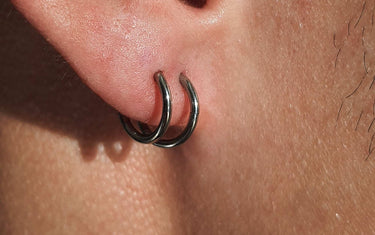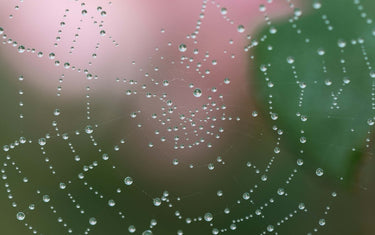8 min read / 9 February 2023 / Laura Garvin Gomez
How to Use Tea Tree Oil for Piercings
When it comes to cleaning and healing wounds, tea tree oil seems to do it all. But how does it respond to piercings?

If you've ever gotten a piercing in your life, you'll know how important the aftercare is.
While it's completely normal to want to show off your new nose ring or helix piercing right away, there's a good chance it won't last longer than a couple of weeks without the right cleaning techniques under your belt.
Fresh piercings are incredibly vulnerable to infections, bumps, and a whole host of other nasties that can leave the area looking inflamed, painful, and generally unpleasant to put up with.
For that reason, piercers all around the world recommend following strict rules for aftercare to avoid these stubborn symptoms until the area is fully healed.
Using tea tree essential oil for piercings is one such remedy that experts have started to look toward, thanks to its long history of strong antibacterial and antimicrobial effects.
We'll be running through how to use tea tree essential oil on your piercings, how it works, and when it's best avoided.
How to Use Tea Tree Oil for Piercings
Tea tree oil can be used to treat piercing bumps after the initial healing period, but it should be diluted before applying:
- Dilute a few drops of tea tree oil with a carrier oil, such as almond, coconut, or jojoba oil. A common ratio is 3 to 5 drops of tea tree oil to 1/2 to 1 ounce of carrier oil.
- Apply the diluted oil to the bump with a clean finger or cotton bud.
- Apply the oil morning and night after cleaning your piercing with a saline solution or as recommended by your piercer.
- Continue applying the oil until the bump disappears.
- Stop using the oil once the bump is gone to avoid over-drying the area.
What is tea tree essential oil?If aromatherapy isn't really your thing, or if you're lucky enough to never have had acne in your life, there's a good chance you might not have heard of tea tree oil and its effects. Tea tree oil, also known by the botanical name Melaleuca Alternifolia, is a strong, herbaceous essential oil extracted via steam distillation from the leaves of the Australian tea tree. It is generally pale yellow to clear in colour, and has been given the nickname of "medicine cabinet in a bottle" thanks to its versatile healing abilities. Once used by indigenous peoples for numerous physical applications, tea tree oil is now most famous for helping to clear skin, reduce dandruff, and speed up wound healing. |
Is tea tree oil good for piercings?
Thanks to its strong antiseptic qualities, tea tree essential oil is considered to work exceptionally well on piercings - but there are precautions.
If you've still got a fresh, open wound in your piercing, there's a high chance too much tea tree oil may actually damage this area further. This is because the oil can be very drying, leading the brittle skin that is more susceptible to cracking and scarring.
To avoid this, it's best to combine tea tree with other aftercare methods like warm water and sea salt, and to ensure it's always diluted with a carrier oil before use (more on this later).
That being said, there's one major area of the healing process that tea tree is undoubtedly perfect for - piercing bumps.
Does tea tree oil remove piercing bumps?
Piercing bumps are a pretty common side effect to the healing process. They are usually situated right next to the wound area, and tend to be inflamed in appearance.
Applying tea tree oil to piercing bumps can help reduce redness as well as keep the area sufficiently clean - allowing them to reduce in appearance over time.
While piercing bumps are totally normal during healing, they shouldn't be ignored. Failure to properly clean a piercing bump can lead to an unwanted side effect known as a keloid.
Keloids are enlarged, raised scars that can develop around various forms of skin damage, including piercings. They can be uncomfortable, unpleasant to look at, and can ultimately lead to the removal of your piercing if they grow too large or become infected.
Using tea tree oil throughout healing can prevent the formation of keloids as well as other forms of infectious scar tissue.
If you do notice a keloid around your piercing, or if you see scars becoming larger and more defined, you should speak to a medical professional to find out the best methods for removal.

What are the benefits of using tea tree oil for piercings?
No matter if you're using tea tree oil for nose piercings, belly button rings, or your common lobe piercing, implementing these benefits into your aftercare is a sure-fire way to ensure a better overall result.
We've listed some of the most impactful benefits of tea tree oil below:
1. It's anti-inflammatory and antimicrobial
Piercings have a habit of becoming red and inflamed during healing. In some cases, they can even become itchy and tender to the touch as a result of inflammation.
Thankfully, tea tree essential oil is renowned for its anti-inflammatory effects, and has developed major acclaim for its ability to reduce swelling as well as clear bacteria.
2. It can prevent infections
Terpinen-4-ol has been studied by various researchers for its successes in fighting against common infections including strep and MRSA, as well as chronic skin conditions like psoriasis. [1] [2]
It is this constituent that also gives tea tree oil its antibacterial, antifungal, antiviral, and antiprotozoal properties.
These effects combined can help keep your piercing free from infection, as well as prevent future infections with frequent application.
3. It can promote wound healing
The antibacterial properties of tea tree oil make it a great agent for speeding up wound healing, which is vital if you want your new piercing looking great as soon as possible.
It is also said to help increase white blood cell activity in the body, meaning it can encourage your immune system to patch up the area quicker than it otherwise would've. [1]

How do I make a salt water and tea tree solution?
When you leave the parlour with your new piercing, it's likely you'll be given some sort of instruction detailing a sea salt and hot water rinse as part of your aftercare.
This step is incredibly important for healing and should always be used alongside any other method you choose to incorporate.
If you're wanting to kill two birds with one stone, however, there's an easy way to include both the tea tree oil and your salt water solution in one:
- Sprinkle a pinch of sea salt into warm water and stir well.
- Apply the solution with a clean cloth to the affected area.
- Add a couple of drops of tea tree oil to the solution and mix well.
- Re-apply as above.
Try to apply the solution before it gets too cold and avoid using more than twice a day.
Ensure you're being gentle but firm when applying, and that you're covering the wound entirely in the process.

Frequently Asked Questions
Can tea tree oil make keloid scars worse?
Tea tree oil works better as a prevention tactic for keloids rather than a solution, however there's no reason why it should make the area worse.
If you notice your keloids becoming more defined, painful, or larger in any way, speak to a medical professional about the appropriate next steps.
What are the best carrier oils for cleaning new piercings?
Carrier oils are crucial for ensuring proper dilution of your tea tree oil.
Most experts recommend using a skin-loving carrier oil with proven moisturising effects, like coconut oil or sweet almond oil.
You can also try out a number of other carrier oils like grapeseed oil or jojoba oil until you find one that's best for you.
How do you know if a piercing is infected?
With any new piercing, there's always a risk of infection.
Signs that your piercing may need attention include redness, swelling, pain, discomfort, and even puss.
If you notice any of these symptoms around your piercing, try upping your aftercare routine to see if things improve.
If nothing budges or matters start getting worse, visit your doctor as soon as possible to avoid having to remove the piercing.
Are there any side effects to using tea tree oil for piercings?
Tea tree oil, like all essential oils, is extremely potent and should always be diluted before use. It's also a good idea to perform a patch test on an area of unbroken skin prior to applying on your piercing.
Cease use immediately if you notice any allergic reactions.
How long does it take for tea tree oil to heal a piercing?
Piercings can take at least six to eight weeks to heal with the proper aftercare measures in place.
Without the use of aftercare measures like tea tree oil or salt water, it can often take much longer - so be sure to choose a routine you know you can stick to!

Piercings are a great way to express yourself, and can be well-loved additions once they are properly healed and secure.
Using essential oils like tea tree to keep the area clean can help fight against infections, bacteria, and other common pitfalls that prevent a piercing from fully healing.
However you choose to apply it, always remember that aftercare is the most crucial part of the piercing process, so be sure not to neglect it!
|
Product Name |
100% Pure Tea Tree Essential Oil |
| Botanical Name | Melaleuca Alternifolia |
| Scent Type | Fresh |
| Benefits & Uses | Decongestant, Skin, Antibacterial |
| Suitable for Diffusers? | Yes, this tea tree essential oil is perfect for diffusers. |
| Suitable for Candles and Soaps? | Yes, this tea tree essential oil is perfect for candle and soap making. |
| Extraction Method | Steam Distillation |
| Bottle Type | Tamper proof and UV resistant |
References
[1] C. F. Carson et al. (2006) Melaleuca alternifolia (Tea Tree) Oil: a Review of Antimicrobial and Other Medicinal Properties https://www.ncbi.nlm.nih.gov/pmc/articles/PMC1360273/
[2] Nader Pazyar et al. (2012) Tea tree oil as a novel antipsoriasis weapon https://pubmed.ncbi.nlm.nih.gov/22473218/
[3] S S Budhiraja et al. (1999) Biological activity of Melaleuca alternifola (Tea Tree) oil component, terpinen-4-ol, in human myelocytic cell line HL-60 https://pubmed.ncbi.nlm.nih.gov/10519561/










